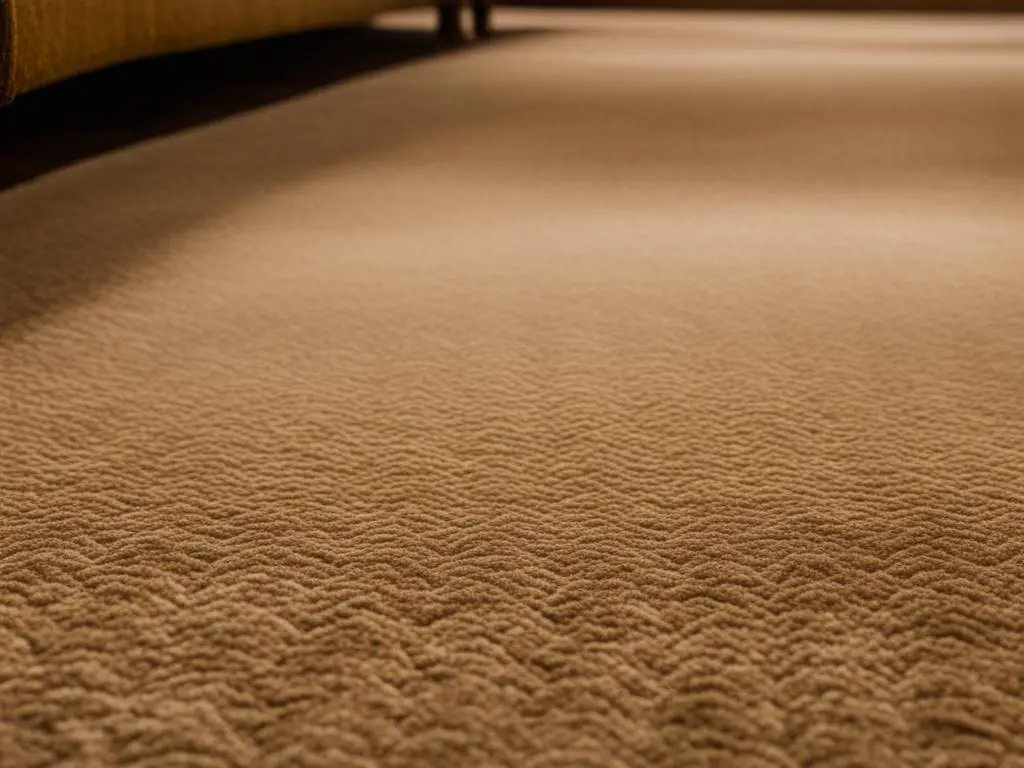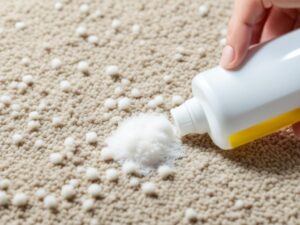Water damage to your carpets can cause a range of problems, from mold growth to structural damage and reduced air quality. It’s important to take immediate action and follow the right steps to repair water-damaged carpets. In this section, we will provide a detailed guide on how to fix water damage on your carpet, including water damage restoration techniques and carpet water damage repair tips.
Key Takeaways:
- Act quickly to repair water damage on carpets to prevent mold growth and further damage.
- Follow proper water damage restoration steps to ensure effective carpet repair.
- Understanding the different types of water damage can help determine if the carpet can be salvaged or needs to be replaced.
- Proper cleaning and drying techniques are crucial to prevent mold growth and restore the carpets.
- Consider replacing the carpet padding during the restoration process to avoid mold and odors.
Types of Water Damage to Carpets
Water damage to carpets can stem from various sources, such as heavy rainfall, burst pipes, or sewage backups. Understanding the type of water damage is crucial for assessing its severity and determining the appropriate course of action. Whether you’re dealing with a minor spill or a major flooding event, knowing the specific damage can help you decide whether the carpet can be salvaged through DIY repair techniques or if replacement is necessary.
There are three primary categories of water damage:
- Clean Water Damage: This category refers to water from a clean source, such as a faucet or supply pipe. It poses minimal health risks and is the easiest to handle. Carpet drying techniques like blotting, extracting excess water, and using fans for airflow can be effective in restoring the carpet.
- Gray Water Damage: Gray water damage occurs when water contains some contaminants, such as urine or detergent. This type of damage can present moderate health risks and may require additional cleaning and disinfection measures. DIY water damage repair can be attempted, but professional assistance is recommended to ensure thorough cleaning and sanitization.
- Black Water Damage: Black water damage is the most severe and hazardous type. It involves water from sewage backups, floodwaters, or stagnant sources, containing harmful bacteria, fungi, and other pathogens. DIY repair is not recommended for black water damage as it requires specialized equipment and expertise. Professional water damage restoration services should be sought immediately to ensure proper cleanup and eliminate health risks.
Knowing the category of water damage that has affected your carpet is essential for undertaking the appropriate DIY repair techniques. However, keep in mind that regardless of the category, acting quickly and efficiently is key to minimizing damage and preventing further issues such as mold growth and structural damage.
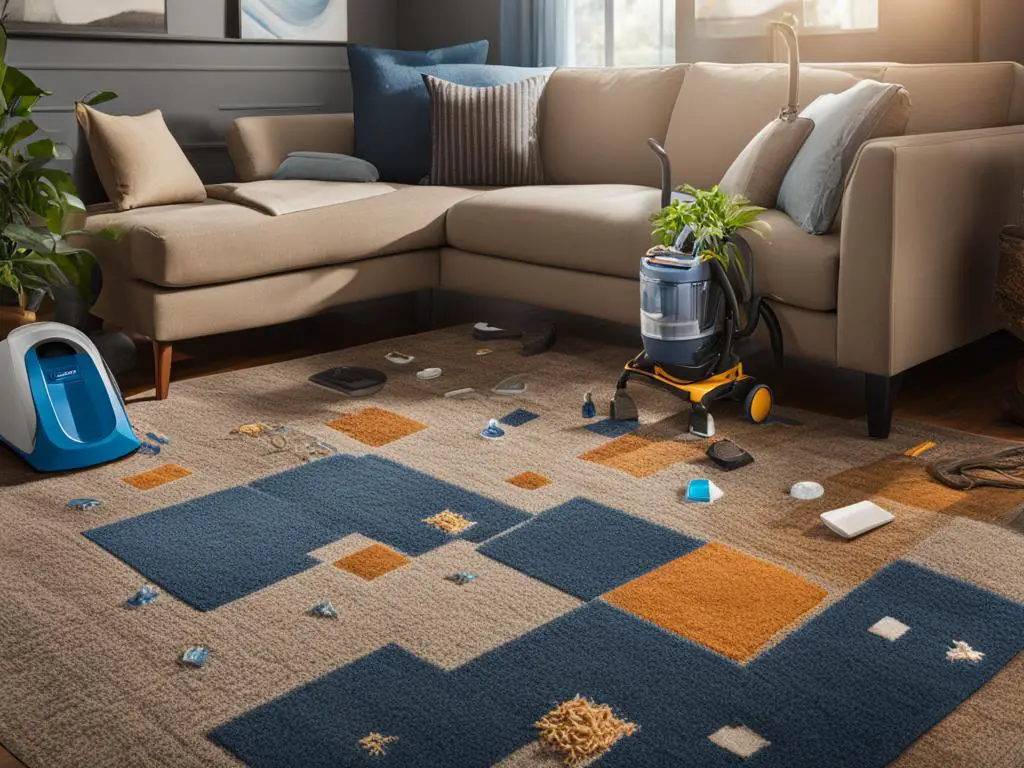
Cleaning Up Water Damaged Carpets
Cleaning up water damaged carpets is crucial to prevent further damage and health issues. When carpets are saturated with water, it can lead to mold growth, structural damage, and unpleasant odors. To restore your carpets and ensure a safe environment, follow these steps for professional water damage cleanup and moisture extraction from the carpet:
- Act quickly: Time is of the essence when dealing with water-damaged carpets. The longer the water sits, the greater the chances of mold growth. Begin the cleanup process as soon as possible.
- Ensure safety: Before starting the cleanup, ensure that it is safe to enter the affected area. Turn off any electrical sources, such as power outlets or appliances, to avoid electrical hazards.
- Remove excess water: Use a wet/dry vacuum cleaner or mop to remove as much standing water as possible. This will help prevent further saturation of the carpet fibers.
- Separate furniture and items: If there is furniture or other items on the carpet, remove them to prevent damage and aid in the drying process.
- Assess the damage: Evaluate the extent of the water damage on the carpet. If the water is clean and the damage is minimal, you might be able to handle the cleanup yourself. However, if the water is contaminated or the damage is extensive, it’s best to seek professional help.
- Professional water damage cleanup: If the damage is severe or the water is contaminated (e.g., sewage backup), it is recommended to hire professional water damage restoration services. They have the expertise, specialized equipment, and knowledge to safely and effectively clean up water damaged carpets.
- Moisture extraction from carpet: Moisture extraction is crucial to prevent mold growth. Professionals use advanced techniques such as high-powered extraction equipment to remove moisture from deep within the carpet fibers. This helps expedite the drying process and prevents mold and mildew issues.
By following these steps, you can effectively clean up water damaged carpets and minimize the risk of further damage and health hazards.
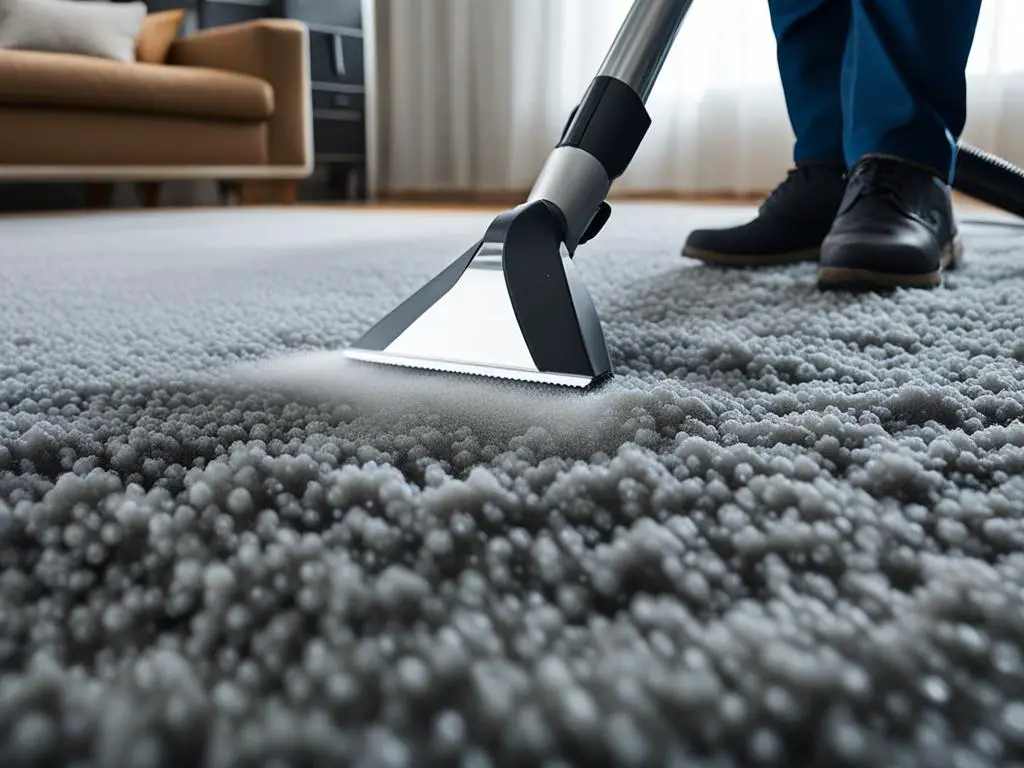
| Importance of Professional Water Damage Cleanup | Benefits of Moisture Extraction |
|---|---|
| 1. Expert knowledge and experience in handling water damaged carpets | 1. Prevents mold and mildew growth |
| 2. Specialized equipment for thorough cleaning and drying | 2. Enhances indoor air quality |
| 3. Minimizes the risk of structural damage | 3. Improves the lifespan of carpets |
| 4. Reduces the chances of health issues caused by mold exposure | 4. Restores the aesthetics of carpets |
Drying Techniques for Wet Carpets
After experiencing water damage on your carpets, it is crucial to take immediate action to prevent mold growth and further damage. Proper drying techniques are essential to restore your carpets to their original state. In this section, we will discuss the best practices for fixing water damage on carpets and highlight the importance of drying them within 48 hours to avoid mold and mildew issues.
Using Box Fans
One of the most effective drying techniques for wet carpets is using box fans. These fans provide a powerful airflow that helps dry the carpet fibers and removes excess moisture. Place the box fans strategically to cover the affected area, ensuring proper ventilation. Keep the fans running continuously until the carpets are completely dry.
Utilizing Wet/Dry Vacs
Wet/dry vacuums are another valuable tool for drying wet carpets. These vacuums are designed to extract moisture from carpets, helping to speed up the drying process. Start by vacuuming the excess water from the carpet, working in small sections. Ensure that the vacuum cleaner is set to the appropriate mode for wet surfaces. Remember to empty the tank regularly to prevent overflow and maximize the vacuum’s efficiency.
Professional-Grade Carpet Fans
In cases of severe water damage or large areas affected, professional-grade carpet fans can be highly effective in drying wet carpets. These fans are specifically designed for water damage restoration and provide a higher airflow volume than regular fans. Position the carpet fans strategically to cover the wet area, allowing for optimal airflow. Consider renting or hiring professionals with access to industrial-grade carpet fans for more efficient drying.
“Proper drying techniques are essential after water damage to prevent mold growth and further damage to the carpets.”
Remember, regardless of the drying technique used, it is crucial to address water damage on carpets promptly. Failure to do so can result in mold growth, unpleasant odors, and permanent damage to your carpets. Now, let’s move on to the next section to learn more about replacing carpet padding after water damage.
Replacing Carpet Padding After Water Damage
When it comes to addressing water damage on carpets, it’s crucial to not only focus on the carpet itself but also the underlying padding. Carpet padding acts like a sponge, absorbing water and creating a breeding ground for mold and unpleasant odors. To ensure effective restoration, it is important to replace the carpet padding along with the damaged carpet.
Replacing carpet padding is a critical step in the water damage restoration process. By removing the wet and compromised padding, you eliminate the potential for mold growth and prevent recurring water damage issues. Additionally, replacing the padding helps improve the overall air quality and ensures a healthier living environment.
The role of professional water damage restoration services cannot be overstated in the process of replacing carpet padding. These experts have the knowledge, experience, and equipment to assess the extent of water damage, remove and dispose of the damaged padding safely, and install new padding with precision.
Professional water damage restoration services offer several advantages when it comes to replacing carpet padding:
- Expert Assessment: Professionals can accurately determine the level of water damage and provide tailored solutions based on your specific situation.
- Efficient Removal: They have the necessary tools and techniques to remove the old padding efficiently, minimizing the risk of further damage to the carpet or other elements of your home.
- Safe Disposal: Proper disposal of the damaged padding is essential to prevent the spread of mold or contamination. Professionals ensure that the disposal is done in compliance with regulations.
- Quality Installation: Professionals ensure that the new padding is installed correctly, guaranteeing optimal performance and longevity.
By hiring water damage restoration services for the replacement of carpet padding, you can save time, avoid the hassle of DIY work, and have the peace of mind that the restoration process is being handled by experts.
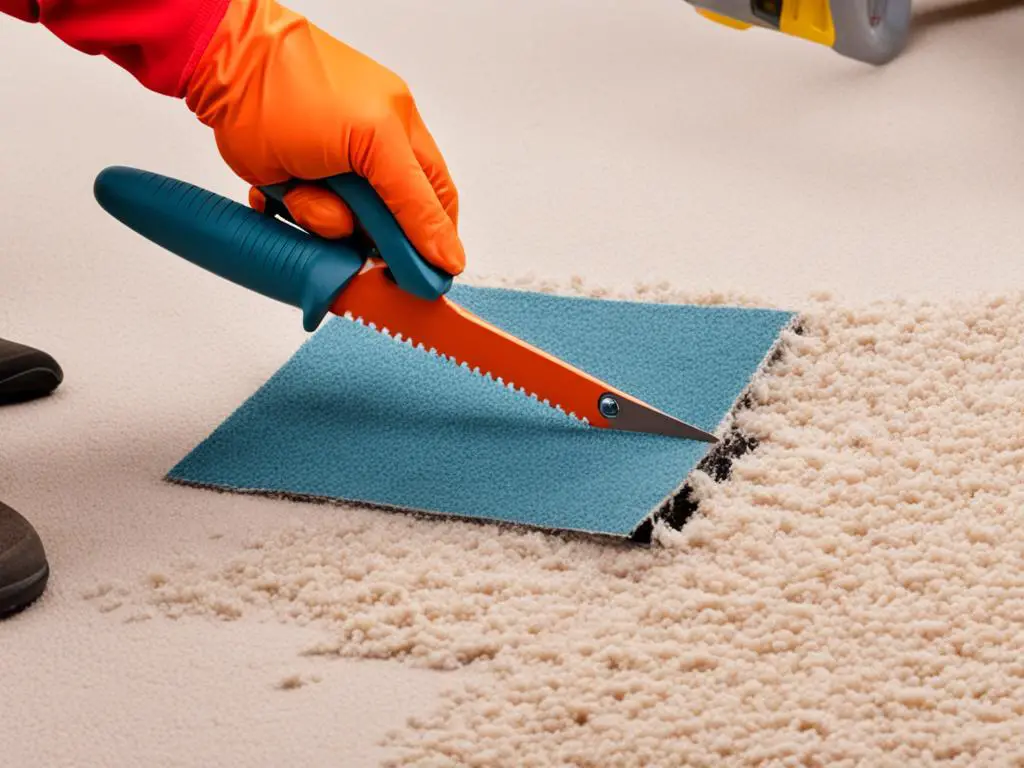
Commercial vs Residential Water Damage Cleanup
Water damage can be a devastating occurrence, affecting both commercial and residential properties. However, the cleanup process can differ significantly based on the type of property. In this section, we will explore the challenges of drying out water damaged carpets in larger commercial buildings and the importance of emergency carpet water damage repair services.
Challenges of Drying Out Water Damaged Carpets in Commercial Buildings
Commercial buildings present unique challenges when it comes to water damage cleanup. These properties often have larger areas of carpeting, multiple floors, and complex layouts. This can make the drying process more time-consuming and intricate.
One of the primary challenges is the scale of the damage. In commercial buildings, water damage incidents can affect substantial areas, requiring extensive drying and restoration efforts. The large volume of water can penetrate deep into the carpet fibers and padding, making it more challenging to extract and dry effectively.
Additionally, commercial buildings may have unique carpeting materials and designs, such as specialized rugs, carpets with intricate patterns, or high-end materials. These carpets require specific care and attention during the cleanup process to preserve their quality and aesthetics.
The Importance of Emergency Carpet Water Damage Repair Services
When it comes to water damage on carpets in commercial buildings, it is crucial to seek professional emergency carpet water damage repair services. These specialized services have the expertise and tools needed to handle the unique challenges of commercial properties.
Emergency carpet water damage repair services offer timely response and expedited cleanup processes, minimizing the disruption to businesses and occupants. They have the necessary equipment, including high-capacity water extraction machines, industrial-grade fans, and dehumidifiers, to efficiently dry out large areas of carpeting.
These professionals understand the intricacies of commercial carpets and can address various carpet types, sizes, and designs appropriately. They can also assess the extent of the water damage, identify hidden moisture pockets, and implement targeted strategies for efficient drying and restoration.
By relying on emergency carpet water damage repair services, commercial property owners can ensure a thorough cleanup, prevent mold growth, and minimize the risk of structural damage. Timely intervention by professionals can save businesses significant costs in the long run and ensure a safe and healthy environment for employees and customers.
| Residential Water Damage Cleanup | Commercial Water Damage Cleanup | |
|---|---|---|
| Property Type | Single-family homes, apartments, condos | Office buildings, retail stores, warehouses |
| Scale of Damage | Limited areas affected | Large areas affected |
| Carpeting Size | Typically smaller areas | Large areas and multiple floors |
| Equipment Required | Standard water extraction tools | High-capacity water extraction machines, industrial-grade fans, dehumidifiers |
| Specialized Carpet Care | N/A | Special attention to unique carpet materials and designs |
Mold Risks and Prevention
Water damage on carpets can lead to mold growth, which poses health risks and can cause further damage. It is crucial to address mold growth promptly to prevent its spread and protect your health. This section will explore the risks of mold growth after water damage and provide essential tips on preventing mold on carpets. By following these preventive measures and implementing proper carpet water damage repair techniques, you can minimize the chances of mold infestation and ensure a healthy living environment.
Understanding the Risks of Mold Growth
When water seeps into carpets, it creates a damp environment that is perfect for mold growth. Mold thrives in dark, moist areas, and carpets affected by water damage provide an ideal breeding ground. The presence of mold can lead to various health problems, including allergies, respiratory issues, and skin irritation. Moreover, mold can spread rapidly, causing structural damage to your home and necessitating costly repairs. It is essential to be aware of the risks associated with mold growth and take preventive measures to safeguard your health and property.
Tips for Preventing Mold on Carpets
Prevention is key when it comes to combating mold growth on carpets after water damage. Here are some effective tips to prevent mold from infesting your carpets:
- Act promptly: As soon as you detect water damage on your carpets, take immediate action to dry and restore them. The longer the carpets remain wet, the higher the chances of mold growth.
- Proper drying: Thoroughly dry the affected carpets using fans, dehumidifiers, or specialized drying equipment. Make sure to focus on both the carpet surface and the underlying padding to prevent hidden moisture pockets.
- Ventilation: Promote air circulation by opening windows, using fans, or running an HVAC system. Proper ventilation helps remove excess moisture and discourages mold growth.
- Clean and disinfect: Regularly clean and disinfect your carpets to prevent the accumulation of dirt, dust, and organic matter that can promote mold growth.
- Control humidity: Maintain a humidity level below 60% in your home to prevent excessive moisture and create an unfavorable environment for mold growth.
By implementing these preventive measures, you can greatly reduce the risk of mold infestation on your carpets. Taking proactive steps and staying vigilant are essential for maintaining a clean, mold-free environment and ensuring the longevity of your carpets.
“Prevention is key when it comes to combating mold growth on carpets after water damage.”
Conclusion
Water damage on carpets can be a serious issue that requires immediate attention. This comprehensive guide has provided valuable insights into water damage restoration and effective carpet drying techniques. By following these guidelines, you can efficiently address water damage on your carpets and restore the comfort and safety of your home.
When dealing with water damage on carpets, it is crucial to act quickly. By utilizing professional water damage restoration services, you can ensure a thorough and efficient cleanup process, preventing further damage, mold growth, and compromised air quality.
Additionally, proper carpet drying techniques play a vital role in the restoration process. Using box fans, wet/dry vacs, and professional-grade carpet fans can expedite the drying time and minimize the risk of mold and mildew growth.
